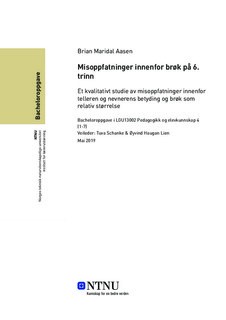| dc.contributor.advisor | Lien, Øyvind Haugan | |
| dc.contributor.advisor | Schanke, Tuva | |
| dc.contributor.author | Aasen, Brian Maridal | |
| dc.date.accessioned | 2019-08-23T14:07:01Z | |
| dc.date.available | 2019-08-23T14:07:01Z | |
| dc.date.issued | 2019 | |
| dc.identifier.uri | http://hdl.handle.net/11250/2610242 | |
| dc.description.abstract | Denne studiens mål har vært å undersøke hvilke misoppfatninger elevene på 6. trinn har innenfor brøk. Fokuset har vært på telleren og nevnerens betydning samt brøk som relativ størrelse og danner da problemstillingen: Hvilke misoppfatninger har elever på 6. trinn i brøk med tanke på oppdeling, nevnerens og tellerens betydning og brøk som relativ størrelse?
Spørsmålet blir forsøkt besvart ved et kvalitativt forskningsdesign med 25 deltaker fra 6. trinn fra en skole i Trondheimsområdet. 25 elevbesvarelser av diagnostiske oppgaver innenfor brøk, observasjon og intervju er lagt til grunn for å besvare spørsmålene.
Det kommer frem i studiet at elevene har misoppfatninger rundt brøk som en relativ størrelse og ikke klarer å se flere helheter i samme oppgave. Videre har også noen elever misoppfatninger rundt oppdeling og viser manglende forståelse for at brøkdelene skal være eksakt like store. Nevnerens og tellerens betydning blir også belyst ved at noen elever tror at teller er det samme som antall deler, uansett størrelse. Noen elever bruker også kunnskapen de har fra før om tall og har misoppfatninger rundt at jo større telleren eller nevneren er, jo større er brøken. | |
| dc.description.abstract | The aim of this study is to investigate which misconceptions 6th grade students have within fractions. Fractions as a relative size and the numerator and denominator’s significance forms the focus area of this study and therefore forms the research question: What misconceptions do 6th grade students within fractions have in terms of partitioning, the significance of the numerator and denominator and fraction as a relative size?
The question is answered with a qualitative research design with 25 participants in the 6th grade from a school in the Trondheim area. These participants responded to a diagnostic test with tasks about fractions relating to the research question. There were also other methods used; observation and interviews with the students where they had the opportunity to explain their thought process.
This study shows that some students have misconceptions about fractions as a relative size and fail to see more than “whole” in the same task. Furthermore, some students also have the misconception within partitioning where they lack the understanding to see that the fraction sizes should be exactly the same size. The significance of the denominator and numerator is also illustrated by the fact that some students believe that the denominator decides how many parts there is, regardless of size. Some students also use their old knowledge about numbers when it comes to fractions and think that the bigger numerator or denominator, the greater the fraction. | |
| dc.language | nob | |
| dc.publisher | NTNU | |
| dc.title | Misoppfatninger innenfor brøk på 6. trinn | |
| dc.type | Bachelor thesis | |
